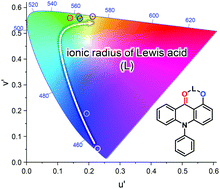Shifting multi-resonance to dipolar intramolecular charge-transfer fluorescence by Lewis acid–base Interactions†
Abstract
Lewis acid–base interactions of 1-hydroxy-10-phenylacridone produce large chromic shifts in fluorescence, due to a change in a multi-resonance intramolecular charge-transfer (ICT) character to a dipolar ICT character.



 Please wait while we load your content...
Please wait while we load your content...